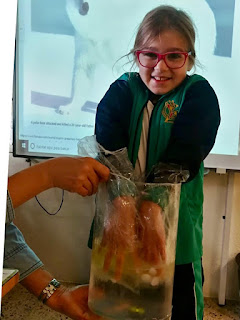- Things to think about how to make a Lego maze:
- How wide does the path need to be?
- Do you use any obstacles?
- Is there anything you can add to make the journey through the maze smoother?
- Is it easier with a smaller or bigger marble. Why?
- Can you make it bigger?
Intercambio de Ciencia Alcobendas
Publicamos ideas y fichas para actividades manipulativos en las ciencias naturales hechas en colegios bilingües en la zona de Alcobendas, Madrid.
Sunday, 14 April 2019
More fun Lego ideas
Science experiments through LEGO engineering
Build a boat and a car powered by a balloon and experience law of motion. We can try with different boat/car shapes and designs and race to see which one works best. You could even try a race between your balloon-powered car and a chemical reaction car . Which is faster?
Wednesday, 10 April 2019
Water pH experiment
We have learnt how different types of water can have varying water pH.
We have used this activity to introduce to the pH scale.
We have used this activity to introduce to the pH scale.
Sunday, 7 April 2019
Wednesday, 23 January 2019
Some plants produce their own light
A plant was created by genetically modifying its structure to include luciferin, a chemical that gives jellyfish their radiant glow.
Today we have used a chemical reaction to make real flowers glow in the dark. Place a white flower into a glass for several hours to absorb the fluorescent highlighter ink.
When the flower has adsorbed the water, its petals will glow!
This experiment uses a "black light".
Black lights look purple, but it's the light they produce that you can't see that's really interesting. Black lights produce ultraviolet (UV) light. Our eyes can't perceive UV light, but our skin can feel it; UV light is the reason we get sunburns.
Some substances, like the ink in many highlighter pens, will glow under a UV light. The fluorescent ink absorbs the energy in the UV light, and then emits it as visible light.
Thursday, 17 January 2019
Why are leaves green?
Chlorophyll is the pigment in leaves. Chlorophyll works by absorbing sunlight and turning it in to energy for the plant.
We can better understand chlorophyll by extracting/removing it from leaves.
This will show us what the true colour of the leaf is, which they can also see in autumn just before the leaves fall off trees.
We can better understand chlorophyll by extracting/removing it from leaves.
This will show us what the true colour of the leaf is, which they can also see in autumn just before the leaves fall off trees.
Sunday, 23 December 2018
How animals survive the winter
We want to show how blubber keeps animals warm.
We fill a container with ice cubes and water then in a plastic bag some vegetable oil and cotton.
Finally we put both hands, one in the oil and one into the ice water.
They all agreed that one hand was freezing and their hand in the oil was warm.
Subscribe to:
Posts (Atom)

























